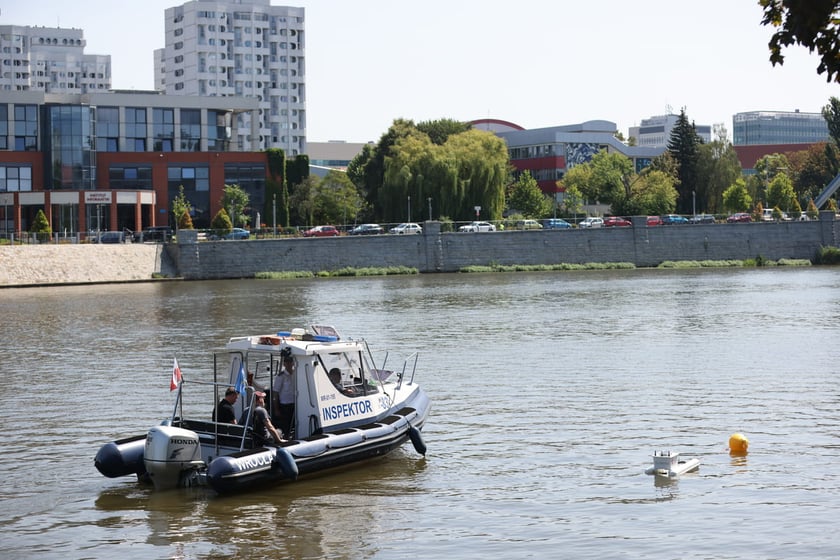The algae invasion and environmental disaster on the Oder River in 2022 has shown that preventive measurements and analysis of water quality parameters in the river are necessary. In Wroclaw, a bet was made on measuring buoys. A year ago these devices were tested, and on July 26 of this year they were launched in two places: at Polinka and at Kaczynski Boulevard. This year, the survey lasted until November 18.
Oxygen, pH and other parameters
Measured indicators:
- suspended solids,
- pH,
- conductivity,
- dissolved oxygen,
- temperature.
- chlorides,
- nitrates.
Our analytical buoys allow us to monitor key water quality parameters in real time, which is essential for rapid response to any threats. Thanks to this advanced technology, we can provide real-time data, which significantly increases the effectiveness of preventive and protective measures.
Director at Smart City & IoT T-Mobile Business Solutions, Piotr Biały
The key indicators are dissolved oxygen and pH, but nevertheless others, such as chloride and nitrate, also have an impact. An elevated value of any of these does not indicate poor water quality. Only a few above the norm raises concern.
The devices collected all the data, which is continuously and in real time transmitted to the Urban Greenery Administration and the Emergency Management Center.
Legend
Level 1 (blue) – waters of the best quality, corresponding to Class I or, if a parameter is not included in the classification, the levels of occurrence of a given parameter that are the most environmentally optimal.
Level 2 (green) – safe; values (along with more favorable ones) that meet the condition of good water status (Class II), or, in the case of indicators not included in the list, the level considered to still reflect conditions close to natural.
Level 3 (orange) – values below good ecological status, warning, periodically tolerated by the ecosystem, but deviating from the optimum.
Level 4 (red) – alarming values of indicators, the persistence of conditions defined by this level leads to the degradation of the ecosystem.
The table and legend were prepared by Dr. Michal Łopata
Data on water quality standards
| Water Quality | Temperature | Oxygen |
pH Level |
Electrolytic Conductivity |
Turbidity |
Chlorides |
Nitrates |
|
°C |
% nasycenia |
Skala pH |
µS/cm |
NTU |
mg/l |
mgN-NO3/l |
|
|
Optimal (Level 1) |
≤22 |
90 - 105 |
7,7 - 8,4 |
≤753 |
≤2 |
≤33,6 |
≤1,6 |
|
Acceptable (Level 2) |
≤24 |
80 - 110 |
7,5 - 8,4 |
≤850 |
≤10 |
≤75,6 |
≤2,2 |
|
Degraded (Level 3) |
>24 - ≤26 |
≥60 - ≤80 lub ≥110 - ≤120 |
≥7,0 -≤7,5 lub ≥8,4 -≤8,6 |
>850 - ≤1500 |
>10 - ≤30 |
>75,6 - ≤150 |
>2,2 - ≤3 |
|
Inadequate (Level 4) |
>26 |
<60 lub >120 |
<7,0 lub >8,6 |
>1500 |
>30 |
>150 |
>3 |
Relevant mainly to river organisms
Tomasz Sikora of the City of Wroclaw's Municipal Office avers that the data contained in the indicators measured on the Oder River within the city of Wroclaw are important mainly for fish and other animals living in the river.
An indication of “inadequate” is not an alarm value for humans or dogs, although any degree other than “adequate” suggests not to use the water. It is worth knowing that everyone can react differently to, for example, increased pH or chloride content. For one body, exceeding the standard may not matter and will not affect well-being or condition, another person or dog may experience, for example, skin irritation. All the more reason to stop pets from drinking river water if any of the indicators deviate from the norm. - Tomasz Sikora
Officials advise against eating fish caught in the Oder River in Wroclaw. This is because their flesh is affected by contaminants from untreated sewage discharged into the river from factories that do not have treatment plants, as well as from water from mines. Tomasz Sikora points primarily to plants located in the upper section of the Oder River, above Wroclaw.






